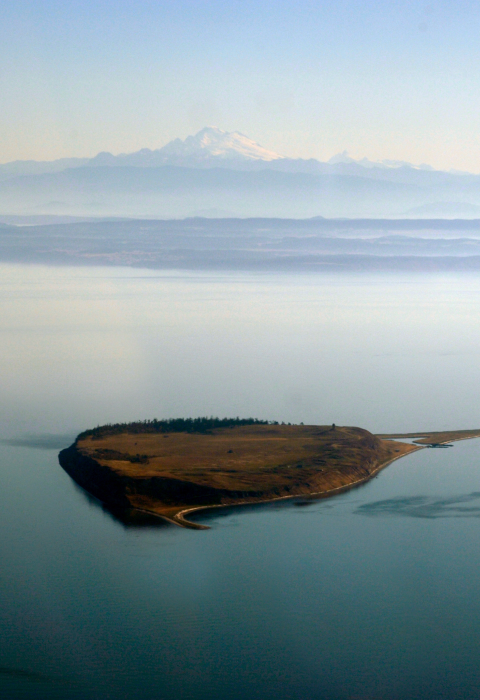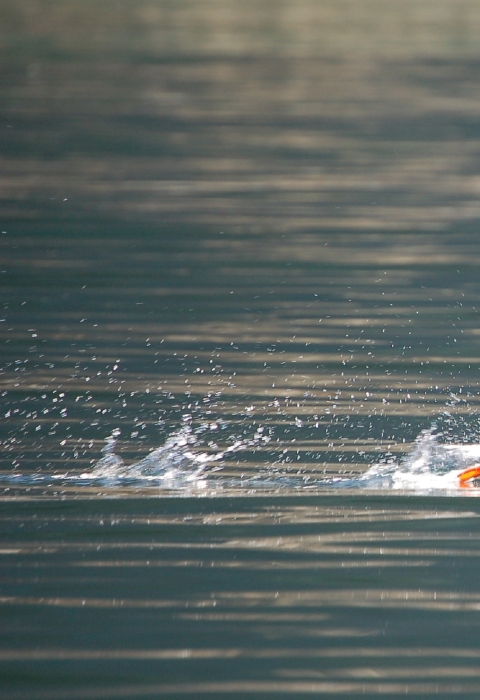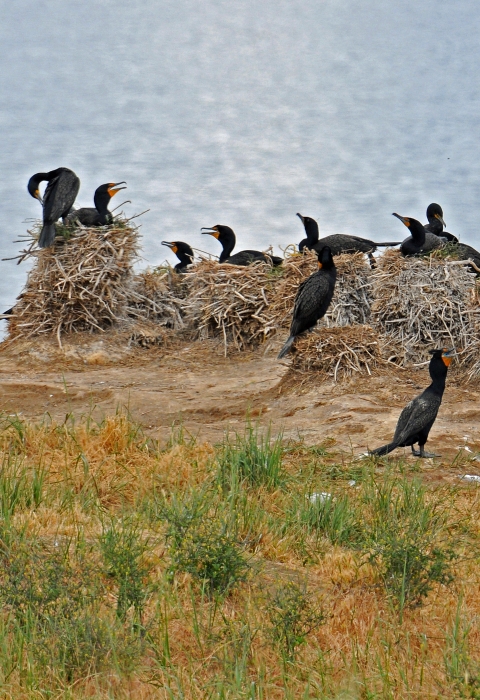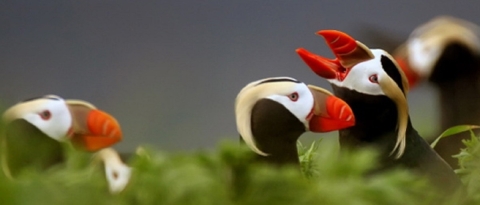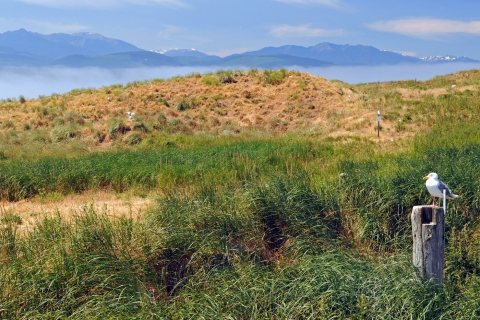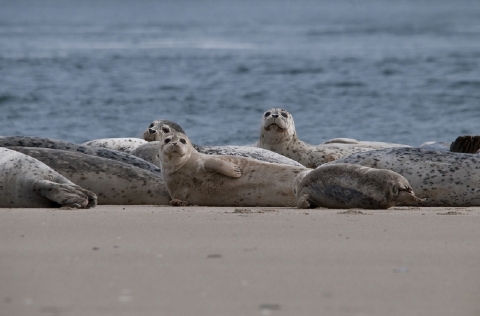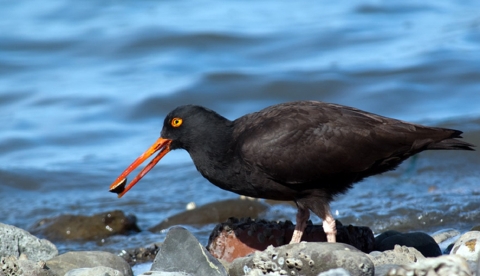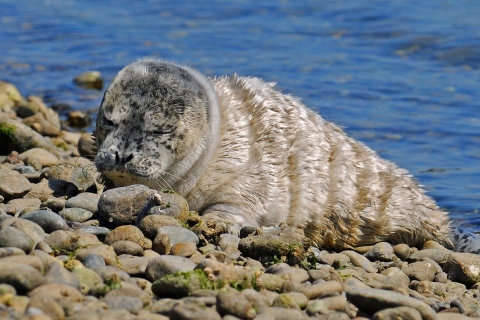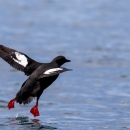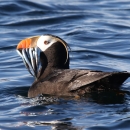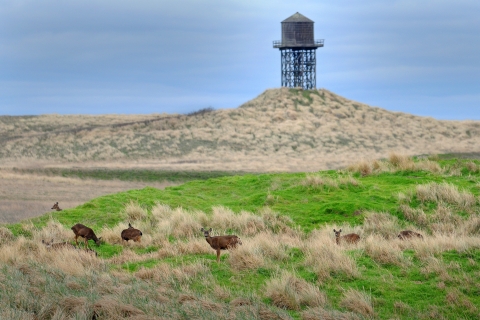To prevent disturbance to extremely sensitive seabirds and marine mammals, Protection Island National Wildlife Refuge is closed to all public access and the surrounding waters within 200 yards are closed to all watercraft.
Protection Island National Wildlife Refuge provides some of the last remaining undeveloped habitat for many burrow-nesting seabirds in the Salish Sea, but is of particular importance to the rhinoceros auklet. Scarred by over a hundred years of farming and grazing, strafed by practice artillery fire during World War II, and carved up for a summer home subdivision in the late 1960’s, its natural significance was finally recognized in 1982 with a National Wildlife Refuge designation before irreversible damage occurred.
Today the Island thrums with life as it continues to recover. It supports thriving wildlife populations, including what is thought to be the third largest rhinoceros auklet colony in North America, a nesting pair of bald eagles, one of the last two breeding sites for tufted puffins in the Salish Sea, the largest glaucous-winged gull colony in Washington state, and the first location in Washington where northern elephant seals were observed to come ashore and give birth.
What a country chooses to save is what a country chooses to say about itself.
- Mollie Beatties, USFWS Director 1993-96
Visit Us
In order to protect this fragile habitat, the Refuge is closed to visitation. Visitors may view the island by boat, but a 200 yard off-shore buffer is enforced to ensure adult birds are not flushed from their nests.
Location and Contact Information
About Us
Protection Island is an important breeding site for a number of birds of the Salish Sea. While it was set aside to protect habitat for a broad range of wildlife it was specifically reserved to provide sanctuary for bald eagles, tufted puffins, rhinoceros auklets, pigeon guillemots, pelagic cormorants, and harbor seals. During breeding season every habitat from the shoreline to the bluffs to the grassland and forest teem with thousands of birds.
What We Do
This 364-acre island is covered by grass and low brush, with a small timbered area, high sandy bluffs where seabirds nest, and low sand spits on two ends of the island. A 200-yard buffer around the island is closed year round to protect wildlife resources. The 48-acre Zella M. Schultz Seabird Sanctuary (on the west end on the island) is managed by the Washington State Department of Fish and Wildlife. Additionally, the island is the centerpiece of the Washington State Department of Natural Resources Protection Island Aquatic Reserve.
Our Organization
Protection Island National Wildlife Refuge is managed as part of the Washington Maritime National Wildlife Refuge Complex. A Refuge Complex is an administrative grouping of two or more refuges, wildlife management areas or other conservation areas that are primarily managed from a central location. Refuges are grouped into a complex structure structure
Something temporarily or permanently constructed, built, or placed; and constructed of natural or manufactured parts including, but not limited to, a building, shed, cabin, porch, bridge, walkway, stair steps, sign, landing, platform, dock, rack, fence, telecommunication device, antennae, fish cleaning table, satellite dish/mount, or well head.
Learn more about structure because they occur in similar ecological regions, such as a watershed or specific habitat type, and have a related purpose and management needs. Typically, a project leader or complex manager oversees the general management of all refuges within the complex while refuge managers may be responsible for operations at specific refuges. Staff, composed of administrative, law enforcement, refuge manager, biological, fire, visitor services, and maintenance professionals, are centrally located and support all refuges within the complex.
Other refuges in the Washington Maritime National Wildlife Refuge Complex include: Dungeness NWR, San Juan Islands NWR, Flattery Rocks NWR, Quillayute Needles NWR, and Copalis NWR. The Refuge Complex headquarters is located at: 715 Holgerson Road, Sequim, WA 98382.
Our Species
Protection Island is an important breeding site for a number of birds of the Salish Sea. While it was set aside to protect habitat for a broad range of wildlife it was specifically reserved to provide sanctuary for bald eagles, tufted puffins, rhinoceros auklets, pigeon guillemots, pelagic cormorants, and harbor seals. During breeding season every habitat from the shoreline to the bluffs to the grassland and forest teem with thousands of birds.
Birds
Protection Island is a crucial site for seabirds of the Salish Sea. Seventy percent of Washington's Salish Sea population of breeding seabirds nest on Protection Island. As human development throughout the region increases, maintaining a pristine habitat for these magnificent creatures becomes more vital. The birds listed here are but a few of the fantastic species that flock to this special island.
Mammals
The shoreline of Protection Island provides essential habitat for members of the seal family. Although they spend much of their lives in water, clean beaches free from disturbances are important to seals so that they can rest, breed, and birth pups.
Protection Island packs a rich variety of habitats into its 364 acres. Gravelly beaches lead to steep, sandy bluffs which are topped with a verdant prairie and small section of forest. The wide mixture of habitats allows many animals to utilize this island.
